“India forces one to come face to face with oneself.”——Peggy Ashcroft as Mrs. Moore
One of producer Richard Goodwin’s Hollywood encounters illustrates the frequent confusion between the two writers E. M. Forster and C. S. Forester. When Goodwin was looking for an American backer for David Lean’s proposed next movie, A Passage to India, and the subject of the novel, British rule in post-World World I India, came up, the studio executive remarked, “Oh, I thought he only wrote Hornblower books.”
While sparing the executive embarrassment with an anonymous reference, Goodwin, at the same time, was providing yet another illustration of the naiveté of some of those Hollywood people. This recalls another executive—I’ve forgotten the film involved, perhaps Mahler or Death in Venice—who liked this fellow Gustav Mahler’s music in the score and urged that the studio sign him. Mahler had been dead since 1911.
No, no! The series of novels about Captain Horatio Hornblower, a hero of the Napoleonic Wars, was the fictional creation of C. S. Forester, with the extra “e.” He also penned The African Queen, which director John Huston turned into a masterpiece with Katharine Hepburn and Humphrey Bogart.
E. M. Forster, quite a different chap, who lived longer than his fellow Brit by a quarter century and was the more scholarly, is renowned for Howard’s End and A Room with a View. These are novels of social consciousness and about class prejudice, as is his most successful novel, A Passage to India of 1924. Forster had taken his title from a Walt Whitman poem, one of many that comprise a collection of poems written and published over the poet’s lifetime as part of his Leaves of Grass. For the remaining forty-six years of Forster’s long life he never wrote another novel.
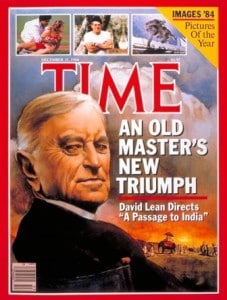 Much like David Lean who never made another film after A Passage to India in 1984, though he lived seven more years. After three triumphs in a row—The Bridge on the River Kwai, Lawrence of Arabia and Doctor Zhivago—he was devastated by the poor reception of his next film, the ponderous and misguided Ryan’s Daughter, and fourteen years would pass before he regained enough confidence to tackle the difficult A Passage to India. It was difficult because of logistics—all equipment and material, even Indian tea, had to be imported to India—and all sets had to be built in general isolation due to the uncontrollable crowds on actual Indian streets and at real temples.
Much like David Lean who never made another film after A Passage to India in 1984, though he lived seven more years. After three triumphs in a row—The Bridge on the River Kwai, Lawrence of Arabia and Doctor Zhivago—he was devastated by the poor reception of his next film, the ponderous and misguided Ryan’s Daughter, and fourteen years would pass before he regained enough confidence to tackle the difficult A Passage to India. It was difficult because of logistics—all equipment and material, even Indian tea, had to be imported to India—and all sets had to be built in general isolation due to the uncontrollable crowds on actual Indian streets and at real temples.
Alfred Hitchcock, like John Ford to a degree, and like most directors, had his special cameraman, editor and composer. So, for this new picture, Lean gathered around him his favorite veterans: cameraman Ernest Day, production designer John Box and Frenchman Maurice Jarre, composer on his three previous films. Robert Bolt, his frequent writer, was replaced by Lean himself, who wrote the script.
Lean, who had begun his British career in the 1930s as a film editor, most notably on Pygmalion in 1938, but who hadn’t worked this art since 1942, decided to edit A Passage to India. At the Oscar ceremonies in Los Angeles in March of 1985, the director had high hopes for A Passage to India, which had received eleven nominations including for the picture, the director, the editing and the script. Unfortunately this was the year of the big sweep for Amadeus, and A Passage to India won only two Oscars—Best Supporting Actress for Peggy Ashcroft and Best Original Score for Jarre. Lean’s disappointment was partly responsible for those last inactive years, that and the beginnings of ill health.
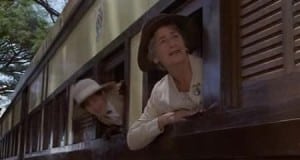 After some promising main title music—Jarre augmented a theme from Ryan’s Daughter, a revealing clue why this is not, over-all, one of his better scores—the film begins outside a London steamship ticket office. It’s raining and the army of moving umbrellas recalls a scene in Hitchcock’s Foreign Correspondent. Adela Quested (Judy Davis) buys tickets to India, for herself and the mother, Mrs. Moore (Ashcroft), of her fiancé Ronny Heaslop (Nigel Havers). Adela gazes at large photographs of the Taj Mahal and the Marabar Caves, a famous tourist attraction outside the village of Chandrapore, her ultimate destination.
After some promising main title music—Jarre augmented a theme from Ryan’s Daughter, a revealing clue why this is not, over-all, one of his better scores—the film begins outside a London steamship ticket office. It’s raining and the army of moving umbrellas recalls a scene in Hitchcock’s Foreign Correspondent. Adela Quested (Judy Davis) buys tickets to India, for herself and the mother, Mrs. Moore (Ashcroft), of her fiancé Ronny Heaslop (Nigel Havers). Adela gazes at large photographs of the Taj Mahal and the Marabar Caves, a famous tourist attraction outside the village of Chandrapore, her ultimate destination.
As the women continue their journey on an Indian train, the theme of Forster’s novel quickly comes to the fore: the clash of cultures between the tens of millions of Indians and the small “garrison” of the ruling British Raj. Onboard are the Turtons, the chief administrator of Chandrapore (Richard Wilson) and his wife (Antonia Pemberton). Mrs. Moore is anxious to meet some of their Indian “friends,” and they politely tell her they don’t associate with the locals.
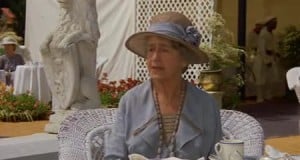 Soon after their arrival, the ladies attend a garden party. The British dance and enjoy their polo and afternoon tea and ignore their so-called invited Indian “guests,” regarding them with contempt. Mrs. Moore is indignant and says so to her apathetic son: “This is one of the most unnatural affairs I have ever attended. . . . I do not see why you all behave so unpleasantly to these people. . . . The whole of this entertainment is an exercise in power, and the subtle pleasures of personal superiority.”
Soon after their arrival, the ladies attend a garden party. The British dance and enjoy their polo and afternoon tea and ignore their so-called invited Indian “guests,” regarding them with contempt. Mrs. Moore is indignant and says so to her apathetic son: “This is one of the most unnatural affairs I have ever attended. . . . I do not see why you all behave so unpleasantly to these people. . . . The whole of this entertainment is an exercise in power, and the subtle pleasures of personal superiority.”
It is one of the moments, certainly, that helped earn Ashcroft her Oscar.
The school superintendent Richard Fielding (James Fox), however, is a refreshing exception to his countrymen’s arrogance toward the locals. He is friends with a Brahmin philosophy scholar, Professor Godbole (Alec Guinness), and treats a poor widower medical doctor, Aziz Ahmed (Victor Banerjee), as an equal.
 In one of the film’s many character studies—the long, intimate kind that clearly marks the director as a student of the old school of film-making—Dr. Aziz first meets Fielding at his home, entering cautiously, yet with curiosity and much anticipation. The Englishman is in the shower singing a tune from Gilbert and Sullivan’s The Mikado. When he says, “Please make yourself at home,” Aziz is both surprised and touched by the man’s cordiality. “May I really, Mr. Fielding? It’s very good of you.” Still having not met face to face, Fielding remarks while dressing that he has broken his back collar stud. Aziz removes his own, saying it’s a spare he keeps in his pocket. Fielding cannot believe any one would carry a stud in his pocket. “I always [do], in case of emergency,” Aziz says. Only then, as Aziz hands the stud to Fielding, do they see each other for the first time.
In one of the film’s many character studies—the long, intimate kind that clearly marks the director as a student of the old school of film-making—Dr. Aziz first meets Fielding at his home, entering cautiously, yet with curiosity and much anticipation. The Englishman is in the shower singing a tune from Gilbert and Sullivan’s The Mikado. When he says, “Please make yourself at home,” Aziz is both surprised and touched by the man’s cordiality. “May I really, Mr. Fielding? It’s very good of you.” Still having not met face to face, Fielding remarks while dressing that he has broken his back collar stud. Aziz removes his own, saying it’s a spare he keeps in his pocket. Fielding cannot believe any one would carry a stud in his pocket. “I always [do], in case of emergency,” Aziz says. Only then, as Aziz hands the stud to Fielding, do they see each other for the first time.
The scene obviously demonstrates Aziz’s kindness and his eagerness to return Fielding’s instinctual generosity. This simple, almost naïve goodness in Aziz’s character will suffer a critical reversal in the climax of the film. Even before then, and unknown to him, this kindness would later be the source of a bigoted remark by Ronny, who has indeed become the “snob” his mother fears, when he notices Aziz’s collar slipping up his neck. “Aziz was dressed in his Sunday best, but he’s forgotten his back collar stud. And there you have the Indian all over.”
After accepting the collar stud, Fielding meets Mrs. Moore and Adela, who have yet to fully perceive the depth of British resentment toward their Indian “inferiors,” and suggest paying Aziz a visit, even asking for the address. Aziz, too embarrassed to reveal the poverty of his dwelling, proposes on the spur of the moment that, instead, he take them on a picnic to the Marabar Caves, involving a long, mountainous train journey. “Ladies, this will be a most magnificent outing.”
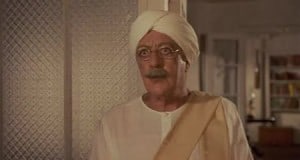 When Godbole, who is also present, is asked about the caves, he is evasive. “There is an entrance which you enter . . . [The caves] are all the same, empty and dark.” As part of his Hindu philosophy, he announces that Mrs. Moore is a fine example of reincarnation, well on her way to achieving nirvana.
When Godbole, who is also present, is asked about the caves, he is evasive. “There is an entrance which you enter . . . [The caves] are all the same, empty and dark.” As part of his Hindu philosophy, he announces that Mrs. Moore is a fine example of reincarnation, well on her way to achieving nirvana.
During the tour of the caves, Adela and Aziz become separated. Adela lights a match in the dark, and she sees him silhouetted in the entrance of the cave. Nothing more is revealed, but she returns home hysterical and in near-shock. Mrs. Moore had earlier returned to their picnic site, having been unsettled by the strange echoes in one cave. When Aziz’s train returns to the Chandrapore station, he is arrested for attempted rape and a trial ensues. Sides are dramatically drawn between the British and the Indians, resentments flaring. At the last moment, Adela withdraws the charge and Aziz is freed, carried from the courtroom on the shoulders of his supporters. Even author Forster is silent about what actually happened in the cave.
In the meantime, Mrs. Moore, who declined to testify against Aziz, believing him innocent, has died of a heart attack on a return voyage to England and is buried at sea.
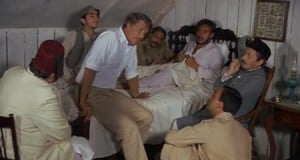 Fielding takes care of the now despondent Adela, and Aziz, feeling betrayed by his friend, leaves Chandrapore and establishes a clinic in Kashmir, in northern India, away from Western, specifically British, influence. After many years and Aziz’s remarriage, Fielding travels to Kashmir in search of him. A bachelor, he, too, has married—Mrs. Moore’s daughter Stella (Sandra Hotz, in her only film role). The two men are reconciled and, in the film’s final scene, Adela reads Aziz’s letter, thanking her for setting him free and asking for forgiveness.
Fielding takes care of the now despondent Adela, and Aziz, feeling betrayed by his friend, leaves Chandrapore and establishes a clinic in Kashmir, in northern India, away from Western, specifically British, influence. After many years and Aziz’s remarriage, Fielding travels to Kashmir in search of him. A bachelor, he, too, has married—Mrs. Moore’s daughter Stella (Sandra Hotz, in her only film role). The two men are reconciled and, in the film’s final scene, Adela reads Aziz’s letter, thanking her for setting him free and asking for forgiveness.
If possessing more of a conventional story line than many of David Lean’s films, with longer dialogue scenes, A Passage to India is equally less visually spectacular, though the director’s eye for the beautiful—and the long shot—is never far away. During Fielding’s cruise to Aziz’s boathouse, the screen is filled with a gorgeous expanse and reflections in a mountain lake. In perhaps the most famous image from the film, a red-robed elephant heads Aziz’s picnic caravan as it moves before the naked gray boulders of the stand-in for the Marabar Caves.
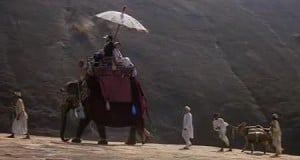 Crowd scenes occur often, and rather early in the especially built Chandrapore market street set the Turton’s car races through without concern for the Indian inhabitants, knocking Aziz and a friend from their bicycles. The affectionate shots of trains in A Passage to India continue that recurring motif in many of Lean’s pictures.
Crowd scenes occur often, and rather early in the especially built Chandrapore market street set the Turton’s car races through without concern for the Indian inhabitants, knocking Aziz and a friend from their bicycles. The affectionate shots of trains in A Passage to India continue that recurring motif in many of Lean’s pictures.
But even more memorable are the intimate scenes—those with Mrs. Moore, either as counselor or censor; the various intrusive Godbole arrivals, which alternately annoy and perplex Fielding; and the already described first meeting of Fielding and Aziz. Something like a complement to that last scene is Fielding’s surprise visit to a sick Aziz. On the one hand, Aziz is ashamed of his house—“the mess, the flies, the plaster coming off the walls!”—yet he shows him a photograph of his late wife. Three times, in between telling him about her, Aziz asks Fielding to put the picture back in its drawer. Fielding is grateful for this sharing. “I showed her to you,” Aziz says, “because I have nothing else to show.”
One of the highlights of the film, intimate to be sure, is the first meeting between Mrs. Moore and Dr. Aziz in the soft, evening glow of the interior of a lattice-enclosed mosque—again, a rather long scene that would be deleted today. As Aziz stares at the river beyond a window, a breeze blows leaves over the tile floor. He thinks he hears something, or someone. He turns—no. He turns back to contemplate the river.
Yes, there is someone. He turns again, now to find Mrs. Moore in white gown and head shawl. He says she has no right here, that she should have removed her shoes. She left them outside, she says. They talk about themselves and their families; he has a son and a daughter and she has a daughter, Stella, by her second husband. Aziz would later say Mrs. Moore appeared to be a ghost. It is all dramatically, atmospherically shot, like the drama it is. As much as the garden party scene, this one helped Ashcroft win that Oscar.
The performances in A Passage to India lack the variety, and depth, of those in, say, The Bridge on the River Kwai—William Holden, Sessue Hayakawa, Alec Guinness, Jack Hawkins and James Donald. Sure, Guinness is in A Passage to India, but it is a different Guinness: in Bridge he is masterful, deserving of his Best Actor Oscar; in A Passage to India he is a caricature of himself, many of his roles epitomized in Godbole, the contrived speech, mannerisms and all. Clearly Bridge is a better film—and has the best score, by Malcolm Arnold, of any of Lean’s epics.
 Victor Banerjee shares with Ashcroft the take-home acting honors of the film. He is animated—in the best sense of the word—and what might be taken at times for over-acting is a carefully nuanced playing of his eccentric, volatile, optimistic character. The other Indian and Pakistani actors, such as Saeed Jaffrey as the judge Hamidullah and Art Malik as Aziz’s friend and defense lawyer, are excellent.
Victor Banerjee shares with Ashcroft the take-home acting honors of the film. He is animated—in the best sense of the word—and what might be taken at times for over-acting is a carefully nuanced playing of his eccentric, volatile, optimistic character. The other Indian and Pakistani actors, such as Saeed Jaffrey as the judge Hamidullah and Art Malik as Aziz’s friend and defense lawyer, are excellent.
James Fox’s first movie role was as Mrs. Miniver’s eleven-year-old son in The Miniver Story in 1950. Despite being a low-key, somewhat bland actor, he conveys quite well the distinctive qualities of Fielding, the humility and generosity that tie him to the central person of goodness in A Passage to India, though less outspoken than Mrs. Moore
 The top-billed Australian Judy Davis gives a fine, Oscar-nominated rendering of Adela, naïve and critically repressed, socially as well as sexually. She is so convincing, in fact, that, contrary to evidence otherwise that she is a consummate actress of great range, a viewer might wonder if she is unconsciously revealing a bit of her real self as well. In working under Lean’s direction, she discovered, as other actors have, that he was something of a “bully.”
The top-billed Australian Judy Davis gives a fine, Oscar-nominated rendering of Adela, naïve and critically repressed, socially as well as sexually. She is so convincing, in fact, that, contrary to evidence otherwise that she is a consummate actress of great range, a viewer might wonder if she is unconsciously revealing a bit of her real self as well. In working under Lean’s direction, she discovered, as other actors have, that he was something of a “bully.”
Maurice Jarre’s score, if sporadic, provides the necessary support and color for a film about India. The conventional large orchestra is supplemented by indigenous instruments appropriate to the subject: the tambour, the dulcimer-like santoor, fujara of the flute family and the sarangi, another string instrument, difficult to play.
Most conspicuous in the scoring are two ondes Martenot, which bear the name of their inventor, Maurice Martenot. The electronic keyboard is similar to the Theremin and invented about the same time. The instruments are used throughout the main title, in fact, they open it, followed closely by two timpani raps, twice repeated, then a drum roll that introduces the “traveling” tune. A brief transition leads to an undulating second theme representing Adela.
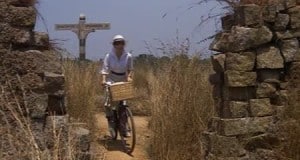 The most impressive music in the score is not the attractive main title nor any music associated with the caves, as might be expected, but that for Adela’s bicycle ride through the ruins of a decaying, overgrown Hindu temple. The scene begins with the traveling theme, very quietly, with the chirping of birds and the “clicking” of her bicycle, cued louder than the music. As Adela surveys the carved stone figures in various erotic embraces, her theme becomes more and more agitated and excited, conveying her awakening sexuality. Apprehension turns to fear as she notices and hears, among the statues and undergrowth, a group of chattering monkeys. They seem distressed by her presence and start approaching her. (Lean’s astute editing deceives the viewer into believing the animals and Adela are in the scene together!) Ominous brass enter as Adela flees on her bicycle and the monkeys seem to pursue her.
The most impressive music in the score is not the attractive main title nor any music associated with the caves, as might be expected, but that for Adela’s bicycle ride through the ruins of a decaying, overgrown Hindu temple. The scene begins with the traveling theme, very quietly, with the chirping of birds and the “clicking” of her bicycle, cued louder than the music. As Adela surveys the carved stone figures in various erotic embraces, her theme becomes more and more agitated and excited, conveying her awakening sexuality. Apprehension turns to fear as she notices and hears, among the statues and undergrowth, a group of chattering monkeys. They seem distressed by her presence and start approaching her. (Lean’s astute editing deceives the viewer into believing the animals and Adela are in the scene together!) Ominous brass enter as Adela flees on her bicycle and the monkeys seem to pursue her.
An ideal summation of A Passage to India comes from Leonard Maltin: “Not a great movie, but so rich in flavor, nuance and the sheer expressiveness of film that it offers great satisfaction, despite its shortcomings (and extreme length).” Extreme length—a failing of all of Lean’s films after 1955.
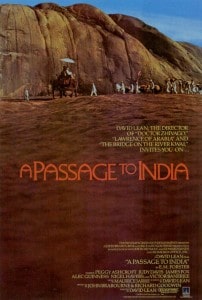
I saw this movie years ago and I could not get into it. I guess most of it went over my head, because so many people rave about it and I didn’t see what the fuss was about. Now that I’ve read your post, I think I should see it again. Besides, I’m a huge Judy Davis fan and she deserves another chance. 🙂